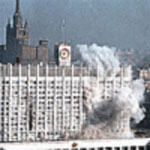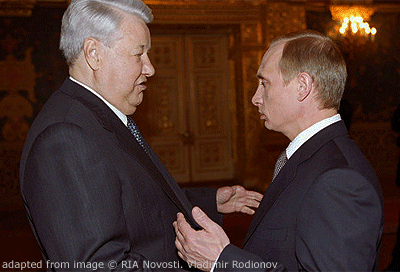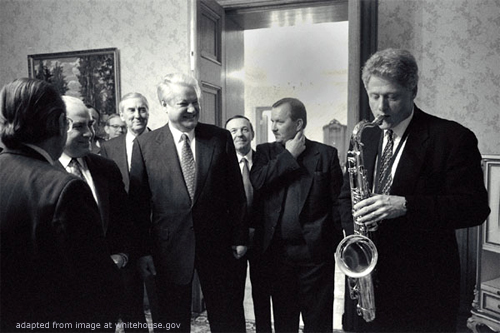Skepticism About US Intentions and Other Enduring Consequences of Russia’s 1993 Crisis

(Russia Matters – russiamatters.org – Paul Saunders – October 4, 2018 – russiamatters.org/analysis/skepticism-about-us-intentions-and-other-enduring-consequences-russias-1993-crisis)
Paul Saunders is the executive director of the Center for the National Interest.
Twenty-five years ago this week, a confrontation between Russia’s then President Boris Yeltsin and the country’s parliament culminated in armed standoffs that left more than 100 people dead and became unambiguously one of the most consequential events in Russia’s post-Soviet history. Nevertheless, outside those who follow Russia closely, few Americans seem to appreciate the profound and lasting consequences of Yeltsin’s forcible dissolution of the legislature, then known as the Supreme Soviet, which persist to this day: It dramatically strengthened the Russian presidency, enabled Russia’s crony capitalism and entrenched Russian skepticism about U.S. intentions. The lack of attention to Russia’s 1993 constitutional crisis not only limits our understanding of modern Russia, but also prevents learning important lessons about the effects of U.S. foreign policy.
Yeltsin’s assault on the parliament building—known as “the White House” and later renovated and transformed into offices for the prime minister and the government—was a long time coming. Tension between Russia’s president and parliament emerged almost immediately following Russia’s independence as Yeltsin imposed major economic reforms that sent prices soaring. Throughout 1992, Yeltsin fought the Supreme Soviet over the increasingly unpopular reforms as well as broader questions of control over policy. (Under Russia’s Soviet-legacy constitution, the parliament had a dominant role and the president was weaker.) In December 1992, the parliament refused to approve Yeltsin’s nominee for prime minister, the liberal economist Yegor Gaidar; Yeltsin made Gaidar acting prime minister and forged ahead even though the ruble had fallen to one-tenth of its value at the beginning of the year—a devastating blow to consumers, enterprises and government budgets at all levels. Yeltsin simultaneously called for a referendum to take four questions on presidential authority and national policy to the Russian people. After a few days of negotiations, Yeltsin and parliament speaker Ruslan Khasbulatov agreed that Yeltsin could rule by decree until an April 1993 popular vote.
Though Yeltsin would win the referendum, his new popular mandate did little to resolve the escalating dispute with the Supreme Soviet, which retained strong constitutional powers. By Sept. 21, a frustrated Yeltsin issued an unconstitutional order to dissolve the Supreme Soviet. The parliament responded by impeaching Yeltsin and installing Vice President Alexander Rutskoy as acting president. Russia entered a full-blown constitutional and political crisis accompanied by protests and violence. A week later, Yeltsin ordered internal security forces to surround the parliament. Following intense violence on Oct. 3, when the lawmakers’ supporters clashed with police near Moscow’s main television tower, the Russian military stormed the Supreme Soviet building, ending the crisis. Khasbulatov and Rutskoy would go to prison, though Yeltsin later forgave Rutskoy sufficiently to appoint him as the governor of Kursk, in western Russia.
These events – from January 1992 through October 1993 – had transformative consequences for Russia and for its relationship with the United States and the West. First, and most important, the victorious Yeltsin resolved never again to be weaker than a defiant parliament. The new constitution that he imposed-through what some observers called a fraudulent process in which Russian election officials overstated voter turnout to reach the threshold necessary for a valid result-dramatically empowered Russia’s presidency at the expense of the parliament. The new, tamer legislature would be a Federal Assembly divided into a lower house (the State Duma, which replaced the Supreme Soviet) and an upper house (the Federation Council, which represents Russia’s regions). At the end of 1999, upon resigning before the end of this term, Yeltsin would hand his new and far more powerful office to then-prime minister Vladimir Putin. Had Putin assumed weaker presidential powers, with more checks and balances, after his election in 2000, Russia would be a different country today.
The new, tamer legislature would be a Federal Assembly divided into a lower house (the State Duma, which replaced the Supreme Soviet) and an upper house (the Federation Council, which represents Russia’s regions). At the end of 1999, upon resigning before the end of this term, Yeltsin would hand his new and far more powerful office to then-prime minister Vladimir Putin. Had Putin assumed weaker presidential powers, with more checks and balances, after his election in 2000, Russia would be a different country today.
Second, Yeltsin’s power allowed him, Gaidar and Russia’s radical economic reformers to implement some of the country’s most important economic policy changes by decree, without parliamentary approval or meaningful oversight. This would include controversial privatization decisions that rewarded political allies and established competing clans of corrupt senior officials and newly minted tycoons. Unrestrained competition among these groups would extend from wars of words among the television channels and newspapers they controlled to gun battles on the streets of Moscow and provincial capitals. While Putin blunted the so-called oligarchs’ political ambitions soon after taking office, Russia’s new economic elites would profoundly distort Russia’s policymaking in Yeltsin’s later years in office and continue to shape it today.
Finally, October 1993 would crystallize Russian elite and public attitudes toward the United States and the West and entrench the mistaken view that America’s objective during this period was to weaken Russia rather than to help Russians survive a difficult transition. This resulted from Washington’s public support for Yeltsin and apparent indifference both to his authoritarian instincts and to the outcomes of his policies for ordinary Russians. Indeed, in hindsight from the world of 2018, Yeltsin’s frequent turns to “the people” to support him-whether against the Soviet Communist Party earlier in his political career, or the Supreme Soviet in 1993-look far more like hallmarks of the populism that so many now decry than of liberalism. More important, however, is that, at the time, many Russians predictably drew the conclusion that America supported Yeltsin, his reforms and his generally acquiescent foreign policy more than it supported democracy in Russia. Ironically, this conclusion was especially widespread among intellectual elites who (unlike most others) had a better understanding of what democracy really meant. Having known and interacted with people like this from those days until now, I find it remarkable how many among Russia’s elite have abandoned earlier pro-American attitudes in favor of wry cynicism regarding U.S. motives and objectives in international affairs.
Ordinary Russians, who had little basis to understand democratic practices, seemed to see democracy less as a set of principles, structures or procedures and more as a means to an end, with the end being prosperity both nationally and personally. In that context, U.S. support for Yeltsin and (implicitly) the results of his policies appeared to mean that Washington was working against the end that Russians sought and, therefore, to call the means into question as well. Beyond this, to the extent that Russians identified the politics that followed with America, Yeltsin’s corrupt 1996 election and Russia’s chaotic crony capitalism tarnished Washington’s reputation and undercut its moral authority. In today’s environment, many continue to cite Yeltsin’s employment of U.S. political consultants in his re-election campaign as evidence of American election interference.
Some former Clinton administration officials have argued that the United States had no practical alternative to supporting Yeltsin, largely by suggesting that the Supreme Soviet was less legitimate than Yeltsin or that its policies would have been more damaging to U.S. interests in Russia. Neither point was persuasive at the time and neither has become more persuasive since. Both Yeltsin and the Supreme Soviet were elected before Russia’s independence under the same Soviet-era rules and procedures. Yeltsin’s success in the April 1993 referendum gave him a political mandate but not a constitutional mandate. This political mandate could have helped Yeltsin win a compromise closer to his terms, but was insufficient for him to demand total surrender from his parliamentary opponents. Conversely, while many in the Supreme Soviet wanted slower reforms more sensitive to social needs, the majority remained supportive of cooperative relations with the United States-then the world’s dominant power and one upon which Moscow would depend for access to international credits and investment. Had they succeeded, Russia could have a parliamentary system much less amenable to authoritarianism and might have managed a smoother economic transition that avoided the excesses of the 1990s. Had they failed, Khasbulatov and his unimpressive allies in the Supreme Soviet would have discredited themselves but need not have discredited the United States too. And Russia might still have a parliamentary system with stronger checks and balances. In that case, Russia’s judicial system may have been able to maintain greater independence too.
 In his book “The Russia Hand,” former Deputy Secretary of State Strobe Talbott chronicled then-President Bill Clinton’s repeated statements of support for Yeltsin before and after the April 1993 referendum and during and after the September-October 1993 crisis. As Talbott writes, on Oct. 3, Clinton publicly blamed violence solely on Rutskoy and Khasbulatov, said that Yeltsin “bent over backward to avoid excessive force” and insisted that he was “still convinced that the United States must support President Yeltsin and the process of bringing about free and fair elections.” Strikingly, we now know that Clinton was even more supportive in his private messages to Yeltsin; according to declassified U.S. government reports, on Oct. 22, then Secretary of State Warren Christopher “told President Yeltsin how much President Clinton admires all that he has done in recent weeks and particularly his firmness in pursuing such a steady course in the face of heavy difficulties.” This is perhaps the clearest evidence of the Clinton administration’s endorsement of Yeltsin’s authoritarian conduct—a statement of presidential admiration—and it is a message that many senior Russian officials would hear. Russians and Americans are still living with the results.
In his book “The Russia Hand,” former Deputy Secretary of State Strobe Talbott chronicled then-President Bill Clinton’s repeated statements of support for Yeltsin before and after the April 1993 referendum and during and after the September-October 1993 crisis. As Talbott writes, on Oct. 3, Clinton publicly blamed violence solely on Rutskoy and Khasbulatov, said that Yeltsin “bent over backward to avoid excessive force” and insisted that he was “still convinced that the United States must support President Yeltsin and the process of bringing about free and fair elections.” Strikingly, we now know that Clinton was even more supportive in his private messages to Yeltsin; according to declassified U.S. government reports, on Oct. 22, then Secretary of State Warren Christopher “told President Yeltsin how much President Clinton admires all that he has done in recent weeks and particularly his firmness in pursuing such a steady course in the face of heavy difficulties.” This is perhaps the clearest evidence of the Clinton administration’s endorsement of Yeltsin’s authoritarian conduct—a statement of presidential admiration—and it is a message that many senior Russian officials would hear. Russians and Americans are still living with the results.
[featured images are file photos]
Article also appeared at russiamatters.org/analysis/skepticism-about-us-intentions-and-other-enduring-consequences-russias-1993-crisis with different images, bearing the notice: “© Russia Matters 2018 … This project has been made possible with support from Carnegie Corporation of New York,” with a footer heading entitled “Republication Guidelines” linking to: russiamatters.org/node/7406, which bears the notice, in part:
“If you would like to reprint one of these articles, a blog post written by RM staff, one of our infographics or a fact-check, we ask that you follow these guidelines:
- Include a prominent attribution to Russia Matters as the source and link back to the original at RussiaMatters.org.
- Retain the hyperlinks used in the original content.
- Do not change the meaning of the article in any way.
- Get an ok from us for non-substantive changes like partial reprints or headline rewrites and inform readers of any such modifications (e.g., This article first appeared on the Russia Matters website with the headline “Russian Election Interference in Trump’s Own Words”).
- Let us know about the reprint and send a link!
Please note that Russia Matters cannot grant permissions for third-party content, including articles, photographs and other materials not produced by our team.
Questions? Email us at RussiaMatters@hks.harvard.edu.”
[featured image is file photo]
